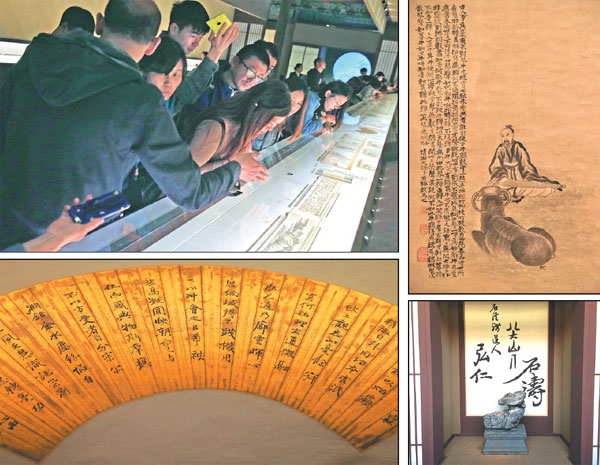The fantastic four monks
An ongoing exhibition at Beijing's Palace Museum showcases the works of Hongren, Kuncan, Bada Shanren and Shitao from the early Qing Dynasty (1644-1911). Wang Kaihao reports.
They are considered some of the best painters among Buddhist monks in ancient China.
Hongren, Kuncan, Bada Shanren and Shitao from the early Qing Dynasty (1644-1911) are referred to as "the Four Monks" in Chinese fine-art history.
An ongoing exhibition in the Hall of Martial Valor at Beijing's Palace Museum - China's royal palace from 1420 to 1911, which is also known as the Forbidden City - showcases their works through the 163 pieces on display.
Visiting the Painting and Calligraphic Works by the Four Monk Artists from the Permanent Collection of the Palace Museum is not only an experience of admiring fine art but also an exploration for those seeking the inner peace of Zen.
"They (the artists) may not belong to the same schools of art, but they endured many ups and downs in their lives," says Wang Hu, curator of the exhibition.
"They were loyal to the previous Ming Dynasty (1368-1644) and had strong views about the newly established (Qing) empire of the Manchu."
The exhibition has four sections, one for each artist.
Animals roll their eyes to express a sense of rebellion in Bada Shanren's works.
However, in one painting, Cat, Stone, and Flowers, he depicts a chubby and sleepy cat on a stone. This work is exquisite as it has different layers created with the skillful use of ink.
"It seems like a reflection of a leisurely lifestyle," says Wang. "However, it also shows that the painter is looking for inner peace after enduring anger and worries."
Wang says some of the works are milestones in the development of Chinese painting.
For instance, a scroll painting by Shitao comprising breathtaking mountain landscapes shows techniques from previous dynasties mixed with his own.
He combines his observations of mountains all over the country into one work.
This piece is commonly considered to be one of his most representative.
Wang says that the vitality and the creativity in their inkwash paintings have continued to influence many generations of artists.
Qing Dynasty emperors had little interest in the Four Monks' works, Wang says. All the 200 paintings by the four, which are now housed in the museum, were bought or collected after the founding of New China in 1949.
Sun Miao, who is in charge of the art design of the exhibition, says that this event is also an attempt by the museum to create a different experience for visitors.
"We've introduced many things from modern art galleries for this exhibition," he says.
"This is to better show the monks' spiritual world."
A miniature Buddhist meditation room has been created in the center of the Hall of Martial Valor. And the tone of the hall is set in a dark color to coordinate with the simple and elegant style of the displays.
Some display boards are made of traditional rice paper.
Stones and the old Chinese guqin (zither) decorate the space.
The corners of the hall are dotted with bonsai - not real trees but jade sculptures from Qing collections.
"We wanted to make this space a garden with a strong literati atmosphere," says Sun.
Between 2008 and 2016, the Hall of Martial Valor held nine seasonal exhibitions of ancient Chinese paintings from the Palace Museum's collection, but they were not themed.
That exhibition model has been abandoned.
Zeng Jun, head of the ancient painting and calligraphic works department at the Palace Museum, says: "We've never taken so much effort to design an exhibition hall before.
"But it is better to narrow down the topics and give more detailed introductions of each artist. Exhibitions are not only about exhibits but laos cultural experiences."
She says the next show will be on Zhao Mengfu, a 13th century painter and calligrapher.
Contact the writer at wangkaihao@chinadaily.com.cn
If you go
8:30 am to 5 pm, closed on Mondays, through June 28. The Hall of Martial Valor (Wuying Dian), The Palace Museum, 4 Jingshan Qianjie, Dongcheng district, Beijing.
|
An ongoing exhibition in the Hall of Martial Valor at Beijing's Palace Museum showcases paintings and calligraphic works by Hongren, Kuncan, Bada Shanren and Shitao, also known as "the Four Monks" in Chinese fine-art history. Photos By Jiang Dong And Wang Kaihao / China Daily |
(China Daily 05/09/2017 page18)























